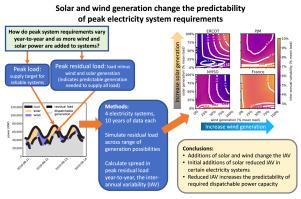Applied Energy ( IF 10.1 ) Pub Date : 2021-09-14 , DOI: 10.1016/j.apenergy.2021.117773 Tyler H. Ruggles 1 , Ken Caldeira 1, 2

|
Electricity systems worldwide are transforming from relying almost exclusively on firm, predictable generation (e.g., fossil, nuclear, and large hydropower) towards incorporating more variable generation (e.g., wind and solar PV). In these systems, the electric load minus generation from variable resources is known as the “residual load.” The peak residual load provides an estimate of the dispatchable power capacity required to supply electric load during all hours. We analyze a decade of concurrent historical electric load and weather data from four electricity systems. For each system, we construct hypothetical, plausible residual load profiles to study the peak residual load values and their spread from year to year, the “inter-annual variability,” as a function of wind and solar generation. The inter-annual variability in the peak residual load can be equated with the spread in dispatchable power capacity required to supply all load from year to year in electricity systems. In each system, adding variable generation changed the inter-annual variability in the peak residual load values. The introduction of variable renewable power is often thought to increase the variability of most electricity systems characteristics. In contrast, using our simple approach, we show the inter-annual variability in peak residual load may decrease with added solar generation in systems where peak load occurs in the summer months. We attribute these reductions to correlations between the availability of solar generation and the hours of peak electric load, which occurred during the hottest days each year, when electric cooling (air conditioning) was likely used. Also, we show the inter-annual variability in peak residual load decreased in certain circumstances when adding wind generation to the system with a winter peaking load. An understanding of how and why this spread in peak dispatchable power capacity changes with increasing wind and solar deployment could inform long-term planning and resource adequacy targets for electricity systems.
中文翻译:

风能和太阳能发电可能会减少某些电力系统中峰值剩余负荷的年际变化
世界范围内的电力系统正在从几乎完全依赖稳定、可预测的发电(例如,化石、核能和大型水电)转变为包含更多可变发电(例如,风能和太阳能光伏)。在这些系统中,电力负荷减去可变资源发电量被称为“剩余负荷”。峰值剩余负荷提供了在所有时间供应电力负荷所需的可调度电力容量的估计。我们分析了来自四个电力系统的十年并发历史电力负荷和天气数据。对于每个系统,我们构建了假设的、合理的剩余负载曲线,以研究峰值剩余负载值及其年复一年的分布,即“年际变化”,作为风能和太阳能发电的函数。峰值剩余负荷的年际变化可以等同于电力系统中每年供应所有负荷所需的可调度电力容量的分布。在每个系统中,增加变量发电改变了峰值剩余负荷值的年际变化。可变可再生能源的引入通常被认为会增加大多数电力系统特性的可变性。相比之下,使用我们的简单方法,我们表明峰值剩余负载的年际变化可能会随着在夏季出现峰值负载的系统中增加太阳能发电而减少。我们将这些减少归因于太阳能发电的可用性与每年最热的日子发生的峰值电力负荷小时数之间的相关性,当可能使用电冷却(空调)时。此外,我们还表明,在某些情况下,当将风力发电添加到具有冬季峰值负载的系统时,峰值剩余负载的年际变化会降低。了解随着风能和太阳能部署的增加,峰值可调度电力容量的这种分布如何以及为何发生变化,可以为电力系统的长期规划和资源充足率目标提供信息。










































 京公网安备 11010802027423号
京公网安备 11010802027423号